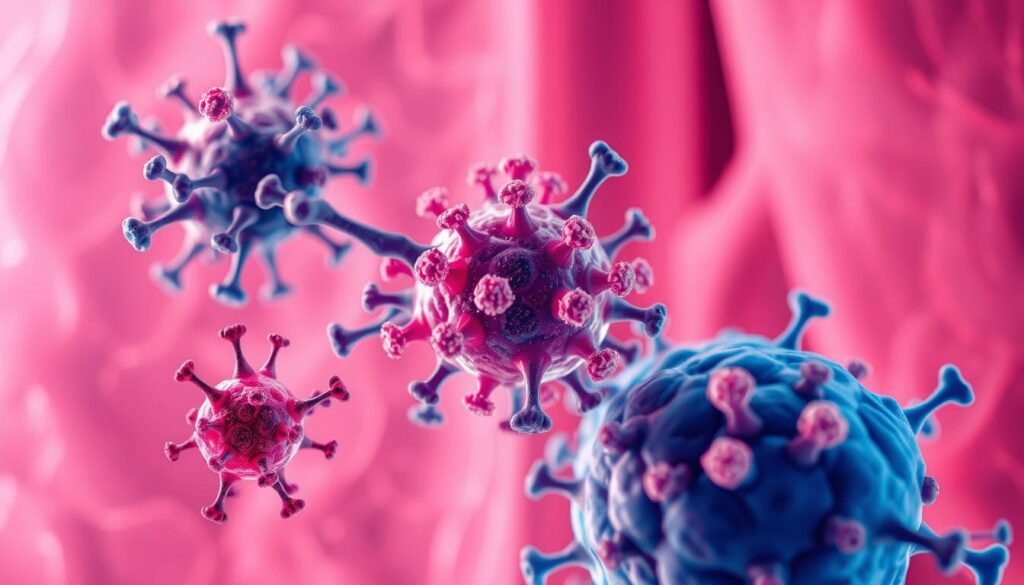About 60% of non-small cell lung cancer (NSCLC) patients might show high PD-L1 levels. This can greatly affect their treatment results. PD-L1 plays a big role in treating lung cancer. It’s important to understand PD-L1 well because it helps decide on the best approach to treat lung cancer. This article will talk about PD-L1, the lung cancers linked with it, how to test for it, and new treatments that use PD-L1 blockers.
Looking into how treatment methods have evolved can help patients and caregivers make better choices. Knowing that high PD-L1 levels usually mean a good reaction to treatments is key. Also, learning from studies and clinical trials can improve how well patients do. For more information on the latest in PD-L1 blockers, check out this detailed article.
Key Takeaways
- PD-L1 testing is crucial for tailoring lung cancer treatment strategies.
- High PD-L1 expression (50% or greater) may indicate a strong response to immune checkpoint inhibitors.
- Combining immunotherapy with chemotherapy is suitable for patients with moderate PD-L1 expression.
- Understanding tumor mutation burden can further inform treatment decisions.
- Continuous communication with healthcare providers can help manage treatment goals and side effects.
- Supportive care resources are available and should be considered early in treatment planning.
What is PD-L1 and its Role in Lung Cancer?
PD-L1 stands for programmed cell death-ligand 1, a key protein that helps control the immune system. It’s found on the surfaces of many cells, including those of cancer, where it interacts with the PD-1 receptor on T-cells. This interaction stops T-cell function, letting cancer cells avoid immune detection and grow freely. Identified as a vital cancer biomarker, PD-L1’s presence often means a tougher battle against pd-l1 lung cancer.
When PD-L1 levels are high, it could mean immunotherapy might work well as a treatment. Studies have shown a link between PD-L1 levels and how non-small cell lung cancer (NSCLC) patients fare with treatments. Knowing a patient’s PD-L1 status can clue doctors in on the best therapies, like PD-1 and PD-L1 inhibitors. This makes understanding PD-L1 crucial since it influences cancer severity and how well treatment might work. Check out the importance of PD-L1 for more details.
PD-L1 isn’t only important in lung cancer, but in many other cancers too, like melanoma, breast cancer, and glioma. Scientists say knowing how PD-L1 interacts in the body is important. It shows us how tumors hide from the immune system. This knowledge opens doors to new treatments.
Cancer treatments targeting PD-L1 are now more common, changing the game for patients. Drugs like Pembrolizumab and Nivolumab are leading the way in treating pd-l1 lung cancer. They offer new hope for better results in fighting this disease.
Understanding PD-L1 Lung Cancer
PD-L1 lung cancer mainly affects non-small cell lung cancer (NSCLC). In NSCLC, PD-L1 protein levels are much higher. This protein plays a key role in the tumor environment. It also guides us in picking the right treatment strategies. Knowing how much PD-L1 is in the body helps doctors choose who might benefit from certain treatments. This is especially true for treatments called immune checkpoint inhibitors.
Immunotherapy is a big step forward in lung cancer treatment. It offers different options from the usual treatments like chemotherapy. Immune checkpoint inhibitors work by targeting PD-L1. They are effective, particularly for those with high PD-L1 levels. These treatments can slow down tumor growth. They also have fewer side effects than older cancer treatments.
To test for PD-L1, doctors analyze tissue samples from biopsies. The results help doctors decide if immunotherapy is a good option. If the PD-L1 test is positive, it means there’s enough PD-L1 for immunotherapy. A negative test might mean looking at other treatments.
Even with progress in PD-L1 lung cancer treatment, results differ from person to person. How well treatment works can depend on the PD-L1 levels and other health issues. It’s important to understand this to give personalized care. This understanding helps doctors get the best results for people with lung cancer.
Types of Lung Cancer Associated with PD-L1
Lung cancer is mainly split into two types: small cell (SCLC) and non-small cell (NSCLC). Of these, NSCLC includes adenocarcinoma, squamous cell carcinoma, and large cell carcinoma. The amount of PD-L1, a protein, is crucial in NSCLC and varies widely among patients.
Studies involving more than 10,000 patients have shown key data on PD-L1 in NSCLC. Around 24% to 60% of NSCLC patients show PD-L1 positivity. This depends on the cutoff values used in tests. Higher PD-L1 levels usually mean a lower chance of survival. For example, the hazard ratios (HR) for PD-L1 expression are: HR 1% at 1.59, HR 5% at 1.44, and HR 50% at 1.52.
It’s important to know the link between lung cancer types and PD-L1 levels. This knowledge helps doctors make better treatment choices, especially with immunotherapies. Current research is looking into how PD-L1 might predict the success of treatments before and after surgery in NSCLC. As treatments for lung cancer grow, understanding PD-L1’s role is key for future therapies.
Immunotherapy and PD-L1 Inhibitors
Immunotherapy has changed lung cancer treatment dramatically. It uses agents known as immune checkpoint inhibitors. These drugs boost the body’s immune response and stop PD-L1 from binding to PD-1. This keeps T-cells active to target and kill tumor cells. It’s a major step forward in treating non-small cell lung cancer (NSCLC).
How Immune Checkpoint Inhibitors Work
PD-L1 inhibitors target proteins that let cancer cells hide from the immune system. By blocking this interaction, these drugs strengthen the immune system’s attack on cancer. How well they work can depend on how much PD-L1 is in the tumors. Generally, more PD-L1 means better response to the treatment.
Common PD-L1 Inhibitors
Pembrolizumab (Keytruda) and atezolizumab (Tecentriq) are key PD-L1 inhibitors. They’re FDA-approved for NSCLC treatment. Research shows patients with high PD-L1 do better with these drugs than with older treatments. Atezolizumab is given by IV or under the skin, every 2 to 6 weeks.
| Drug Name | Type | Administration Method | Approved Use |
|---|---|---|---|
| Pembrolizumab | PD-1 Inhibitor | IV infusion | NSCLC |
| Atezolizumab | PD-L1 Inhibitor | IV infusion or subcutaneous | NSCLC |
| Nivolumab | PD-1 Inhibitor | IV infusion | NSCLC |
| Durvalumab | PD-L1 Inhibitor | IV infusion | NSCLC |

Testing for PD-L1 Expression
Testing for PD-L1 is key for lung cancer treatment plans. It involves checking tumor samples for PD-L1 protein levels. Immunohistochemistry (IHC) is a main method used for this. It measures PD-L1 levels to see if immunotherapy is a good fit.
Accurate PD-L1 testing shapes treatment choices. It can also open doors to clinical trials, offering new treatment options.
The Importance of PD-L1 Testing
PD-L1 testing plays a vital role. Drugs like nivolumab, pembrolizumab, and atezolizumab have shown strong results against non-small cell lung cancer (NSCLC) in trials. There are different tests for PD-L1, each one suited for certain lung tissue samples.
Oncologists must know that assays for PD-L1 vary. They differ in terms of what counts as “positive.” This highlights the need for awareness about different testing cutoffs and tumor requirements.
| Assay | Concordance | Staining Patterns |
|---|---|---|
| SP263 | High | Membrane staining of tumor cells |
| 22C3 | High | Membrane staining of tumor cells |
| 28-8 | High | Membrane staining of tumor cells |
| SP142 | Lower | Reduced membrane staining |
Assays for PD-L1 are not all the same, which can confuse diagnosis. Projects like Blueprint are working towards unified PD-L1 testing standards. No perfect test exists yet, making it hard for doctors to predict who will benefit from PD-1 blockers.
Choosing the right test is crucial in matching treatments to a patient’s cancer. This ensures the best care based on individual cancer characteristics.
Interpreting PD-L1 Test Results
Understanding PD-L1 results is key in lung cancer treatment. PD-L1 levels in tumor cells show which treatments might work best. Knowing if PD-L1 expression is high or low helps doctors pick the right treatment approach.
High PD-L1 Expression and Treatment Options
If at least 50% of tumor cells show PD-L1, this is high expression. It usually means better outcomes with immunotherapy. Patients with high PD-L1 taking Pembrolizumab in trials saw significant benefits. It’s crucial to score PD-L1 levels accurately since drugs like Pembrolizumab are preferred first-line treatments.
- Pembrolizumab as a treatment option for patients with a PD-L1 score ≥50%.
- Combination therapies involving Pembrolizumab and chemotherapy for enhanced efficacy.
Low PD-L1 Expression and Alternative Treatments
When PD-L1 scores are below 50%, doctors need to look at other treatments. Traditional chemotherapy is one option for those not showing high PD-L1 levels. Targeted therapies based on the tumor’s genetic makeup are also considered to get the best results.
- Traditional chemotherapy for patients with low PD-L1 expression.
- Utilizing targeted therapies tailored to individual tumor biology.

| PD-L1 Expression Level | Treatment Options |
|---|---|
| High PD-L1 Expression (≥50%) | Pembrolizumab, Combination with Chemotherapy |
| Low PD-L1 Expression ( | Traditional Chemotherapy, Targeted Therapies |
Combining PD-L1 Inhibitors with Other Therapies
Using PD-L1 inhibitors with other treatments marks significant progress in lung cancer care. Combination therapy shows great promise for better results, especially in non-small cell lung cancer (NSCLC). Studies indicate that combining immunotherapy with chemotherapy can greatly improve survival rates for those with intermediate PD-L1 levels (1%-49%).
This approach uses the power of targeted therapy, which attacks specific cancer-related molecules or cells. By adding PD-L1 inhibitors to targeted therapies, doctors aim to boost effectiveness and reduce resistance risk. Recent trials show that adding PD-1/PD-L1 inhibitors to chemotherapy improves survival and response rates for patients.
Research involving over 4,500 patients found that combining PD-(L)1 inhibitors with chemotherapy significantly lowers progression risk and extends survival. The hazard ratios for progression-free survival stood out at 0.61, showing a clear benefit over just chemotherapy. These advantages were consistent across different patient groups, irrespective of PD-L1 expression levels.
The successful results from these studies hint at bright prospects for pd-l1 inhibitors used with other treatments. This approach not only enhances treatment options but also advances lung cancer therapy overall. For those interested in learning more, you can find additional information here.
Potential Side Effects of PD-L1 Treatments
PD-L1 treatments offer new hope for lung cancer patients with immune checkpoint inhibitors. Patients should know about potential side effects. These drugs can cause various adverse reactions by affecting the immune system. Some side effects are mild, but others are severe and need careful monitoring.

Monitoring and Managing Side Effects
Managing side effects is vital for patients’ quality of life during PD-L1 therapy. Research shows about 66.0% of patients face adverse events. Fatigue and pruritus are common, affecting 18.26% and 10.61% of patients respectively.
Serious side effects occur in 14.0% of patients, with significant fatigue reported in 0.89%. Hypothyroidism is another common issue, seen in 6.07% of patients. Early detection and management are crucial. This requires teamwork between patients and doctors to address symptoms quickly and adjust treatment plans.
| Adverse Event Type | All-Grade Incidence (%) | Grade 3 or Higher Incidence (%) |
|---|---|---|
| Fatigue | 18.26 | 0.89 |
| Pruritus | 10.61 | N/A |
| Diarrhea | 9.47 | N/A |
| Anemia | N/A | 0.78 |
| AST Increase | N/A | 0.75 |
| Hypothyroidism | 6.07 | N/A |
| Hyperthyroidism | 2.82 | N/A |
Talking with doctors about side effects and management strategies is important. Knowing what to expect can help patients take an active role in their care. This understanding creates a partnership where patients feel comfortable discussing their concerns and making necessary changes to their treatment.
Future Directions in PD-L1 Lung Cancer Treatment
The world of PD-L1 lung cancer treatment is changing fast. Advances in immunotherapy are promising better results for people with advanced non-small cell lung cancer (NSCLC). New research in lung cancer is creating exciting treatment options that could be better than traditional chemo.
FDA-approved immune checkpoint inhibitors have changed how we treat this cancer. Studies show these treatments help patients live longer than old methods. For example, treatments like nivolumab and pembrolizumab are helping NSCLC patients. They’re living 9.2 to 12.2 months longer on average.
The future looks bright for PD-L1 treatment, with more focus on biomarker technology. Techniques like 28-8, 22C3, and SP142 measure PD-L1 levels. This helps personalize treatment plans to match each tumor’s unique aspects. These steps could greatly improve patient results.
Current research includes the ARCTIC study, which is looking at durvalumab for NSCLC patients who’ve had treatment before. This study is part of a larger effort to mix different therapies. The goal is to find the most effective way to treat lung cancer.
Going forward, using artificial intelligence in planning treatments will likely make personalized medicine even sharper. The progress in immunotherapy and biomarker research is set to change lung cancer care. It aims to make treatment more targeted and focused on what patients need.
Conclusion
The study of PD-L1 in lung cancer shows big steps forward in treatment. By looking at research from 877 patients, we understand more about PD-L1 and its effects on survival rates. This shows that patients with non-small cell lung cancer (NSCLC) who have high PD-L1 face a higher risk, highlighting the importance of personalized treatment plans.
Targeted therapies, like PD-1/PD-L1 inhibitors atezolizumab and pembrolizumab, are changing the game. These treatments, when combined with chemotherapy and other methods, improve patient survival and quality of life. This underscores the need for detailed testing and treatments designed for each individual.
The outlook for lung cancer treatment is optimistic, thanks to ongoing research and innovation. Doctors are learning more about PD-L1 and how it affects lung cancer. This knowledge is shaping a future where treatments are more customized and effective. Making therapy specific to each patient is key in improving outcomes and giving hope to those facing this tough disease.